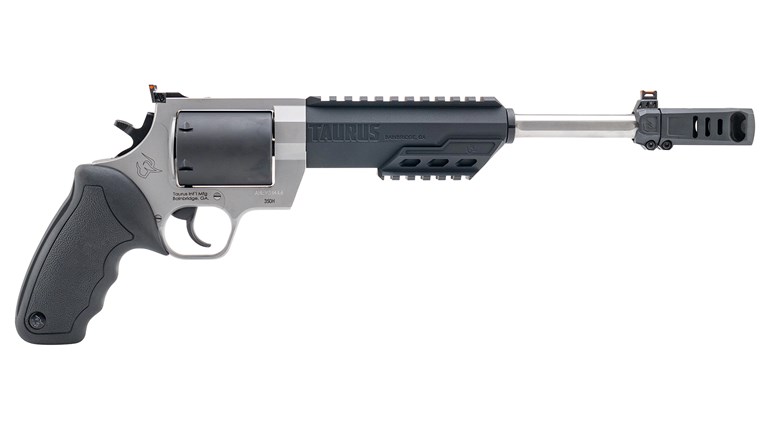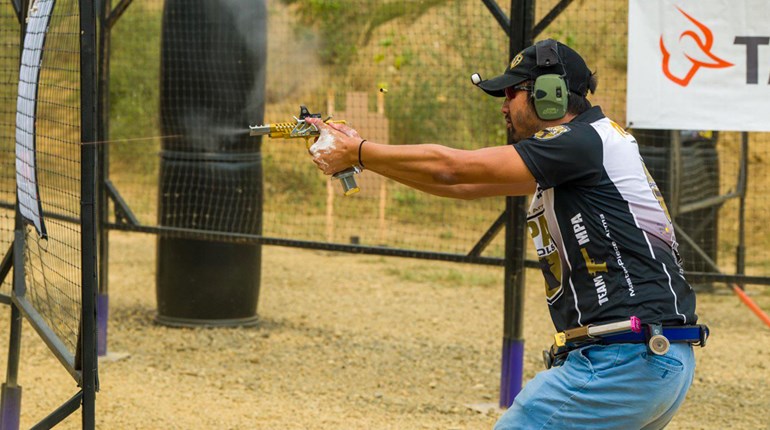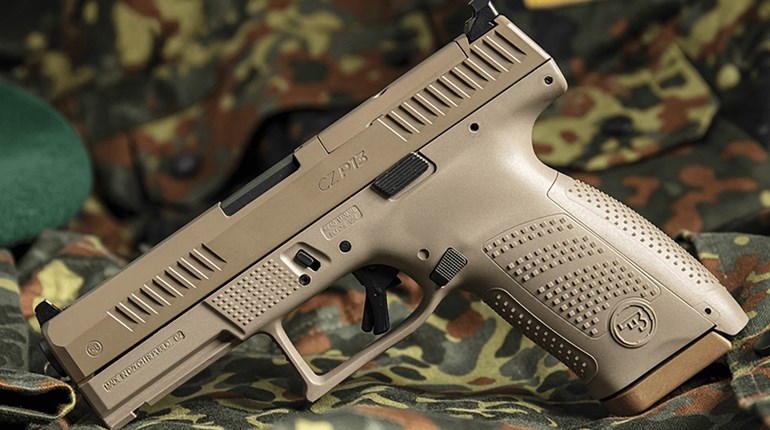
Above: 2016 USPSA Production Nationals Ladies Champion Ashley Rheuark shooting her GLOCK G34. Photo by USPSA.
Here's what shooters competing at the 2016 USPSA National Championships were using, broken down by division.
Open Division
This is USPSA's full-bore race gun division where almost anything goes. There are no limitations on handgun size, authorized modifications, or handguns permitted for the Division. The result is highly-customized handguns with ported barrels, lightened slides, compensators, and red dot sights. There is no minimum trigger pull weight, nor a maximum ammo capacity for the magazines; which are allowed to be 171.25 mm (6.742-inches) in length.

It's possible to convert a polymer-framed GLOCK or S&W M&P into a compensator-equipped Open Class gun, and about $2,000 will do it. However, most Open guns are built on a 1911 platform. These will run $2,800-$6,000, and are preferred.
Of the competitors at the 2016 National Championship 59 percent of the Open Class shooters chose the 1911 platform with STI reigning at 59 percent. The remaining shooters chose the 1911 platform SV Infinity at 14 percent, the Phoenix Trinity 14 percent, and CK with 8 percent.
Major and Minor scoring is used, and Open is one of only two Divisions (Revolver is the other) where .38/9 mm may be loaded to reach a 165 Major Power Factor (PF). The 171.25 mm magazines (most of which are custom-crafted) will approach a 29 round capacity with .38 Super or 9 mm rounds, but hold less in .40 S&W and .45 ACP. It's not surprising that competitors chose the .38/9 mm loads, since 'more bullets' equals less time reloading on the clock (and the high pressures they produce make the compensators more effective at keeping the gun 'flat'). The .38 Super class can be handloaded to make Major with published data. The 9 mm (Major) is a 'do it yourself' project that requires great care and goes above established pressure levels.
Of the competitors, 99 percent chose the .38/9 mm package. The .38 Super Comp round was used by 46 percent, with the .38 Super seeing 14 percent use. The 9 mm (not specified as to Major or Minor loading) was used by 39 percent, but in this writer's experience it's a safe bet that the majority were handloaded to 9 mm Major. The survey showed that 94 percent of Open Class competitors used handloaded ammo, with a 125- or 124-grain fully-jacketed bullet being used by 90 percent.
The optical sight is critical in Open, and the overwhelming choice was the C-More System (88 percent).
Limited and Limited 10 Division
This is the home of high-capacity semi-autos but without the 'bells and whistles' of Open Class. Iron sights are required. Compensators and barrel porting are prohibited, although slide lightening cuts are allowed. This division is also scored Major and Minor, but the minimum bullet diameter allowed for Major is .40 caliber (.40 S&W or 10 mm). Magazine lengths of up to 141.25 mm (5.561-inches) are allowed.

These magazines can hold upwards of 18-19 rounds of .40 S&W, 22-23 of 9 mm, and considerably less in the fatter .45 ACP. Given the Major PF scoring advantage it's not surprising that 90 percent of the competitors opted for the .40 S&W―with 80 percent of all competitors handloading their rounds.
The guns chosen reflected the preference for the 'cocked and locked' 1911 platform seen in the Open Division. Of the shooters, 53 percent, chose the STI platform, with 14 percent opting for the SV Infinity, and 7 percent selecting the Phoenix Trinity. Although the GLOCK G35 was created with this division in mind, only 9 percent of competitors used it.
The Limited 10 Division was created to allow Limited Division guns to compete in those states that enacted magazine capacity rules. The gun and equipment rules for Limited apply. The only difference is that magazines can only hold 10 rounds after the Start signal. Similar to Limited, 86 percent of shooters opted for the .40 S&W cartridge, with 9 percent choosing the 9 mm.
The most popular handgun choice mirrored Limited: 44 percent STI, although the GLOCK 35 gained some following at 19 percent, with Springfield Armory HD series guns coming in at 15 percent.
Single Stack Division
This division was created for the classic John Browning 1911. Handguns used must be available to the general public and built on the original 1911 design, with a metal frame. Iron sights in the traditional post and notch are mandated. No compensators or optical sights. Maximum gun weight is 43-ounces with an empty magazine, and the gun must fit into a box that matches the dimensions of the original 1911.

The most popular choice was Springfield Armory at 31 percent, followed by STI at 30 percent, Colt at 5 percent, with Caspian Arms, SIG Sauer, and Kimber all coming in at 4 percent each.
Major and Minor caliber scoring is used, with .40 bullet diameter being the minimum allowed for Major. But there is a twist. Major calibers are allowed only eight rounds in their magazines, while Minor calibers are allowed 10 rounds. Some shooters feel that two round increase would offset the Major caliber scoring advantage by forcing less reloads for a faster stage run, and 20 percent chose 9 mm. One percent opted for .38 Super. Others felt differently, with 49 percent staying with the .45 ACP and 30 percent choosing the .40 S&W.
Production Division
Production Division gun and holster rules virtually mirror the IDPA Stock Service Pistol Division (SSP). This allows striker-fired guns as well as traditional DA/SA guns; which must start from a hammer down DA position. Iron sights in the post and notch configuration are required, and very few modifications are allowed beyond internal modifications to reduce trigger pull and reliability. The only significant difference between Production and SSP is that the gun must be on the approved Production Pistol list, which requires a certain number of those guns having been produced.

All Productions guns, regardless of caliber, are scored Minor. The maximum magazine capacity is 10 rounds. With the minimum caliber 9x19, it is not surprising that 96 percent of the competitors chose the 9 mm, with only 4 percent opting for the .40 S&W. The majority of shooters (75 percent) used handloaded rounds.
The handguns chosen were CZ at 33 percent, GLOCK at 25 percent, Tanfoglio at 15 percent, Springfield Armory at 8 percent, S&W 6 percent and SIG Sauer at 6 percent.
Carry Optics
This gun division was recently created in response to the increasingly-popular trend of mounting a compact reflex red dot sight directly to the slide of a semi-auto pistol. It is a Provisional Division, meaning rules can change quickly. As originally established it was, essentially, a Production Division-legal gun with a slide-mounted reflex sight. All Production Division holster and magazine capacity rules applied, but magazines of 141.25 mm (the same as Limited Division) were allowed—but with only 10 rounds loaded.

Given that the division is scored Minor, the 9 mm predominated, with only a handful of shooters opting for the .40 S&W. That allowed 34 percent of the shooters to use factory ammo, with 66 percent choosing to load their own.
By model, the most popular gun was the S&W M&P C.O.R.E at 11 percent, with the M&P five-inch Pro Model at 5 percent. The SIG P320 showed at 6 percent, with the CZ Shadow, GLOCK G34 MOS, and G17 MOS coming in at 5 percent each.
The reflex sight is a key component, and 38 percent choose a Leupold Delta Point, 23 percent selected the Trijicon RMR, 13 percent chose the Burris FastFire III, 11 percent used the Vortex, with 9 percent mounting the SIG Romeo.
Those were the rules in 2016, but in 2017 a major change took place. The 141.25 mm magazines remained, but the 10 round capacity limit was abolished. Carry Optic (CO) shooters can now stuff those mags to capacity! The TTI base pads for my Trijicon-equipped 9 mm M&P C.O.R.E will hold 22 rounds. That's significant because under the previous 10 round capacity rule a shooter on a 32 round field course would require a minimum of three reloads (maybe more, depending on how the COF laid out). With the new capacity rules, starting with 22+1 and reloading 22, means there is only one reload required on the longest COF USPSA allows, and the shooter can choose where to make it. That saves time.
Some shooters are already referring to CO as “Open Lite”, and maybe it is. But it will be a lot more fun than making all those reloads!
Revolver Division
This is where wheel gun enthusiasts get to play. Major and Minor scoring is used, and .38/9 mm calibers are allowed to be loaded to the 165 Major PF. There are no restrictions on gun size, weight, minimum trigger pull, and barrel length or holster/loading device position. Iron sights are mandated. Ported barrels or compensators are prohibited.

It was originally conceived for six-shot DA revolvers, and the S&W 625 .45 ACP ruled, although some shooters used light .357 Magnum loads.
A major rule change several years back totally changed the division. The new breed of eight-shot, moon clip-fed .357 and 9 mm guns were now allowed. These guns could now compete with eight rounds in Minor caliber, while Major caliber handguns were restricted to six rounds.
Although Major scores higher in points, USPSA rules allow up to eight rounds to be fired from one shooting position and many COF designers use all eight rounds. For a Major caliber shooter that means a time-killing 'standing reload'―and leaving the position with four rounds in the gun that required further standing reloads. The eight-shot revolvers could clean a position and reload on the move to the next. Speed counts in the score, and despite the Minor PF, eight-shot revolvers became the dominant wheel gun in USPSA. That was certainly confirmed at the 2016 USPSA National Championship.
Of the handgun makes chosen, 97 percent chose S&W, with 3 percent selecting a Ruger. The caliber selection can indicate the exact models chosen with 32 percent using 9 mm (S&W 929), while 23 percent chose the .38 Short Colt, 19 percent .38 Special, and 11 percent the .38 Super (all likely from a S&W 627). Only 15 percent of competitors opted for the traditional .45 ACP (S&W 625) while 1 percent used the .40 S&W in Major (likely from an S&W 610).
Times change. Traditions can go by the wayside. And the 2016 USPSA Nationals show who competitors want for a partner when they go to the Big Dance.
Some additional reading:



































